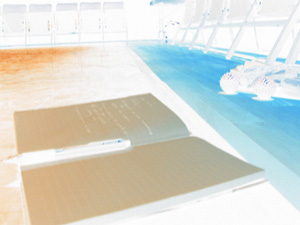Origins of the Clash project
Introduction by Lynda Gaudreau, Artistic Director of Clash

This project is in line with a personal path I have taken over the last few years, connected with my experiences with the Encyclopœdia series. In creating this choreographic suite I invited other artists to take part, to freely collaborate, which allowed me to reflect on my own practices, on diverse choreographic approaches, modes of production and presenting methods used both here and in Europe.
It was my years spent in Europe, in fact, that showed me how closely presenting and creation are connected. Presenting will develop if creation develops at the same time. At present, the topics of presenting, touring, funding and lack of money tend to dominate all discussions of contemporary dance. As a result, the works themselves suffer. Presenting is essential, of course, but what about creation and artists? Creation is seldom mentioned, and yet it is facing a number of major challenges.
I met several artists over the years. I had the privilege of meeting them on site, in a creative context, and conversing with them. Their lives touched me deeply. With very modest means, they were nonetheless driven by a phenomenal desire and creative impulse. Our highly stimulating conversations made me realize how much artists need to communicate, reflect, and share their ideas with other artists.
This project also addresses needs that I myself felt as a choreographer: to question my own work methods and to establish contact with other artists. Although I've had the opportunity to collaborate with several artists, creation has been for the most part a solitary pursuit. It is not really possible to exchange ideas on a regular basis with a dramatist or assistant. Furthermore, although I've almost always allowed for periods of research for my works, this has become increasingly difficult to do over the past few years owing to financial and logistical constraints. This is a common reality for the majority of my dance colleagues.
I have also come to realize how close I feel to artists from other generations, younger in most cases. At first, I wanted to bring young and older artists together in a spirit of mentoring or guidance. But it gradually became clear that collaborative projects should include all artists, regardless of age or experience, and I liked the idea of upsetting the balance between the generations. Rather than basing the project on mentoring activities, I therefore decided to open it up to multiple collaborative models, albeit circumscribed: collaborations between artists that would lead to unusual work methods. The overall aim of the project is thus to build a framework for creative renewal.
At present, there are very few projects designed to revitalize dance theory and practice, for either younger or experienced artists. Analysis and risk-taking, as a result, have become increasingly difficult. What I fear more than anything is a certain uniformity or homogenization of works and practices. Clearly, it is time for reflection, investment, commitment.
Artists have new needs, their production methods are changing; new creative forms are appearing, new realities emerging. The artistic potential is clearly there. It appears essential to channel it towards new creative territory.
The Clash project stems from this need to support creation, within the younger generation in particular. A pilot project, it attempts to provide a structure for people to come together to discuss current practices and to reflect on new creative approaches. It will involve elemental research, as well as risk-taking. What I have in mind is a creative process that questions today's world, that tries to see the world in a different way.